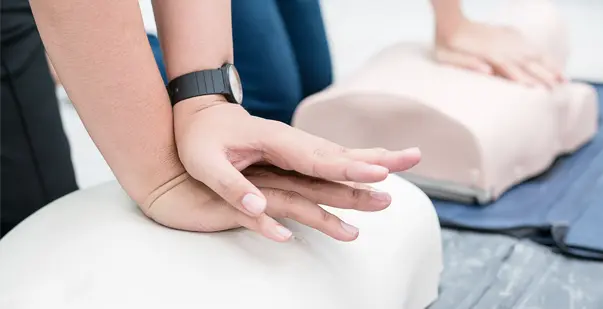
Last Updated On: March 12, 2025
CPR or cardiopulmonary resuscitation, is one of the most well-known medical procedures in the world. With a combination of 30 chest compressions and necessary and mandated two rescue breaths, a trained bystander can intervene in the event of a life-threatening medical emergency and drastically increase the victim’s chance of survival. CPR can be the difference between life and death in emergency medical situations like cardiac arrest, stroke, smoke inhalation, near-drowning, or electrocution. The bystander also checks in with the patient to check if the person is unconscious before performing CPR and helping them revive their heartbeats on time.
In this blog, we’re taking a closer look at CPR and breaking down the 7 fundamental steps of this important, life-saving procedure. The American CPR Care Association is dedicated to providing high-quality and accessible CPR training to as many people as possible. This is why we offer 100 percent online CPR certification and recertification courses.
With just a few clicks, you can begin learning the essential steps of CPR or cardiopulmonary resuscitation and other life-saving medical procedures, like First Aid or how to use an automated external defibrillator (AED). By starting CPR training classes, you’ll have the knowledge, skills, and confidence to respond in the event of an emergency.

CPR, quite simply, can save lives. Every year, hundreds of thousands of people experience cardiac arrest, and roughly 475,000 American lives are lost to this medical condition. Because so many of these episodes occur outside of a hospital, a majority prove to be fatal. In fact, according to the Center for Disease Control and Prevention (CDC), 70 to 90 percent of “out of the hospital cardiac arrests” (OHCA) are fatal.
After calling 911, it can take some time for medical personnel to arrive on the scene. Following a cardiac arrest episode, however, every second matters. This is why the actions of bystanders may prove to be the difference between life and death.
CPR is a relatively straightforward medical procedure that anyone can learn. Even those outside of the medical field can benefit from learning the critical CPR steps. With proper training, anyone can gain the skills and confidence to save a life.
It’s important to note that the following steps are for performing CPR on an adult. While administering CPR to a child or infant is similar, there are significant differences between the techniques. It’s essential to take comprehensive CPR training courses that cover the distinctions between adult, child, and infant CPR.

If one is nearby, you should also use an AED (automated external defibrillator) on a cardiac arrest victim. These small medical devices are designed to reset the victim’s heartbeat to correct an irregular rhythm (arrhythmia). These devices are small and easy to use and can be found in many public places, such as hospitals, schools, and government buildings. When you receive your CPR certification, many programs also include training on how to safely and effectively use an AED on a cardiac arrest victim.
If you’re interested in becoming CPR certified, we highly recommend looking into online CPR certification classes. Compared to the traditional model, online CPR classes are convenient, fast, and tend to be more cost-effective. Online classes are designed to fit your needs and schedule. You can start and stop your lessons at any moment and learn CPR and other emergency medical procedures at your own pace. For those with a hectic schedule, online CPR training is ideal.
We all hope to never find ourselves in the midst of a life-threatening medical emergency. However, if the moment does arise, don’t you want to be prepared? This is why earning your certification is so important. By earning your CPR certification or recertification, you’ll learn the 7 steps of CPR, how to use an AED, and how to respond effectively in the event of an emergency such where victim’s heart stops beating. Even if you aren’t in the medical field, CPR training is important.
To train as many individuals as possible, American CPRCare Association is proud to offer 100 percent online CPR certification classes. We also offer CPR/AED courses that train you how to properly use an automated external defibrillator (AED). Learning these valuable medical skills has simply never been this easy, convenient, or affordable.
For more information on our CPR certification, CPR/AED certification, or other medical certification courses that we offer visit https://cprcare.com or reach out via our email or phone at info@cprcare.com or 1-888-808-9109. We look forward to helping you gain the skills, knowledge, and confidence to save lives.
